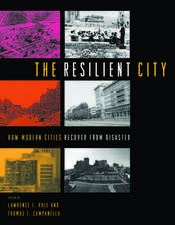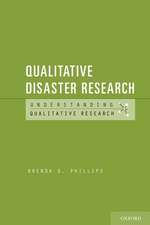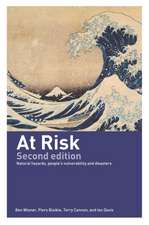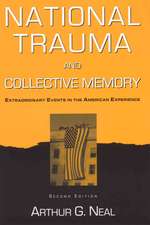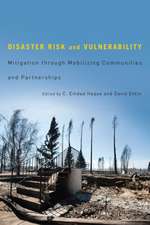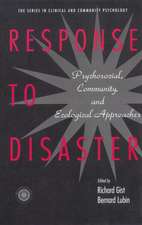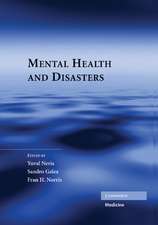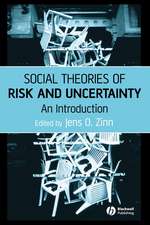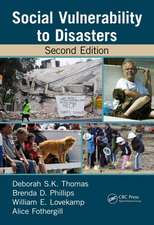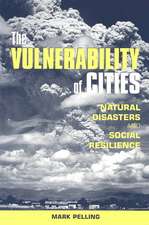Handbook of Hazards and Disaster Risk Reduction
Editat de Ben Wisner, Jc Gaillard, Ilan Kelmanen Limba Engleză Hardback – 13 dec 2011
Organized into five inter-related sections, this Handbook contains sixty-five contributions from leading scholars. Section one situates hazards and disasters in their broad political, cultural, economic, and environmental context. Section two contains treatments of potentially damaging natural events/phenomena organized by major earth system. Section three critically reviews progress in responding to disasters including warning, relief and recovery. Section four addresses mitigation of potential loss and prevention of disasters under two sub-headings: governance, advocacy and self-help, and communication and participation. Section five ends with a concluding chapter by the editors.
The engaging international contributions reflect upon the politics and policy of how we think about and practice applied hazard research and disaster risk reduction. This Handbook provides a wealth of interdisciplinary information and will appeal to students and practitioners interested in Geography, Environment Studies and Development Studies.
| Toate formatele și edițiile | Preț | Express |
|---|---|---|
| Paperback (1) | 604.97 lei 6-8 săpt. | |
| Taylor & Francis – 22 dec 2011 | 604.97 lei 6-8 săpt. | |
| Hardback (1) | 1429.40 lei 6-8 săpt. | |
| Taylor & Francis – 13 dec 2011 | 1429.40 lei 6-8 săpt. |
Preț: 1429.40 lei
Preț vechi: 2144.25 lei
-33% Nou
Puncte Express: 2144
Preț estimativ în valută:
273.51€ • 298.03$ • 230.48£
273.51€ • 298.03$ • 230.48£
Carte tipărită la comandă
Livrare economică 23 aprilie-07 mai
Preluare comenzi: 021 569.72.76
Specificații
ISBN-13: 9780415590655
ISBN-10: 0415590655
Pagini: 908
Ilustrații: 32 b/w images, 32 tables, 13 halftones and 19 line drawings
Dimensiuni: 174 x 246 x 56 mm
Greutate: 1.84 kg
Ediția:1
Editura: Taylor & Francis
Colecția Routledge
Locul publicării:Oxford, United Kingdom
ISBN-10: 0415590655
Pagini: 908
Ilustrații: 32 b/w images, 32 tables, 13 halftones and 19 line drawings
Dimensiuni: 174 x 246 x 56 mm
Greutate: 1.84 kg
Ediția:1
Editura: Taylor & Francis
Colecția Routledge
Locul publicării:Oxford, United Kingdom
Public țintă
Postgraduate, Professional, and UndergraduateCuprins
Foreword 1. Challenging Risk: We Offer the Reader a Left Foot Book Section 1: Big Picture Views – Hazards, Vulnerabilities and Capacities 2. Introduction to Section 1: Big Picture Views – Hazards, Vulnerabilities and Capacities 3. Framing Disaster: Theories and Stories Seeking to Understand Hazards, Vulnerability and Risk 4. Historical Concepts of Disasters and Risk 5. Politics; power and disasters 6. Human Rights, Disasters and State Obligations 7. Violent Conflict, Natural Hazards and Disaster 8. Culture, Hazard and Disaster 9. Knowledge and Disaster Risk Reduction 10. Religious Interpretations of Disaster 11. Hazards and Disasters Represented in Film 12. Hazards and Disasters Represented in Music 13. Hazard, Risk and Urbanisation 14. Disaster Risk and Sustainable Development Section 2: Fine-Grained Views – Hazards, Vulnerabilities and Capacities 15. Introduction to Section 2: Fine-Grained Views – Hazards, Vulnerabilities and Capacities 16. Data Sources on Hazards 17. Tools for Identifying Hazards 18. Hazard, Risk and Climate Change 19. Coastal Storm 20. Thunderstorm and Tornado 21. Flood 22. Drought 23. Extreme Heat and Cold 24. Wildfire 25. Landslide and other Mass Movements 26. Earthquake 27. Tsunami 28. Volcanic Eruption 29. Soil Erosion and Contamination 30. Human Epidemic 31. Livestock Epidemic 32. Plant Disease, Pests and Erosion of Biodiversity 33. Hazards From Space 34. Disability and Disaster 35. Gender, Sexuality and Disaster 36. Children, Youth and Disaster 37. Elderly People and Disaster 38. Caste, Ethnicity, Religious Affiliation and Disaster Section 3: Preparedness and Response 39. Introduction to Section 3: Preparedness and Response 40. Early Warning Principles and Systems 41. Preparedness, Warning and Evacuation 42. Emergency Management Principles 43. From Damage and Needs Assessments to Relief 44. Health Care and Disaster 45. Food Security and Disaster 46. Settlement and Shelter Reconstruction 47. Psycho-Social Recovery 48. Socio-Economic Recovery Section 4: Planning, Prevention and Mitigation 49. Introduction to Section 4: Planning, Prevention and Mitigation 50. International Planning Systems for Disaster 51. National Planning and Disaster 52. Local Government and Disaster 53. Urban and Regional Planning and Disaster 54. Financial Mechanisms for Disaster Risk 55. Economic Development Policy and Disaster Risk 56. Protection of Infrastructure 57. Social Protection and Disaster 58. Livelihood Protection and Support and Disaster 59. Community Action and Disaster 60. Civil Society and Disaster 61. University Research’s Role in Reducing Disaster Risk 62. Education and Disaster 63. Media, Communication and Disaster 64. Participatory Action Research and Disaster Risk Section 5: Conclusion 65. Challenging Risk: Has the Left Foot Stepped Forward?
Recenzii
"The take-home message is that to fully understand the implications of the worlds of hazards and disaster risk, people must better understand vulnerabilities and how they create the wicked problems of communities. Undoubtedly the most comprehensive book on these topics to date. Summing Up: Essential" -CHOICE, August 2012
Descriere
The Handbook provides a comprehensive statement and reference point for hazard and disaster research, policy making, and practice in an international and multi-disciplinary context. Specifically, it aims to provide critical reviews and appraisals of the current state of the art and future development of conceptual, theoretical and practical approaches as well as empirical knowledge and available tools.
One intention is to encourage dialogue across disciplinary barriers among notions of ‘disaster risk reduction’ and ‘vulnerability’ (central concepts within the hazards and disaster community), ‘climate change adaptation’ and ‘sustainable livelihood security’ (core notions underlying much work within the climate and environmental studies community), and ‘poverty reduction’ (which remains a pivotal rallying point within development studies). The international reach and scope of the Handbook’s coverage and contributors’ experience allow engagement with and reflection upon these bridging and linking themes as well as the politics and policy of how we think about and practice applied hazard research and disaster risk reduction.
One intention is to encourage dialogue across disciplinary barriers among notions of ‘disaster risk reduction’ and ‘vulnerability’ (central concepts within the hazards and disaster community), ‘climate change adaptation’ and ‘sustainable livelihood security’ (core notions underlying much work within the climate and environmental studies community), and ‘poverty reduction’ (which remains a pivotal rallying point within development studies). The international reach and scope of the Handbook’s coverage and contributors’ experience allow engagement with and reflection upon these bridging and linking themes as well as the politics and policy of how we think about and practice applied hazard research and disaster risk reduction.

